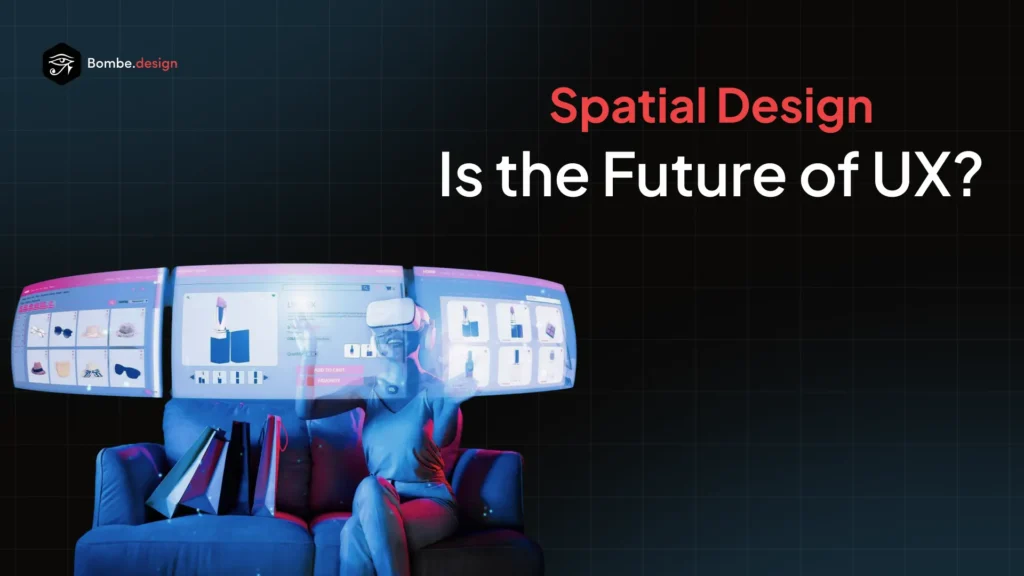Spatial design is transforming how we experience technology blending digital and physical worlds into seamless, immersive interactions that go far beyond traditional screens. Major tech giants like Meta and Apple are investing heavily in AR-powered smart glasses and headsets, creating new ecosystems where users engage naturally with 3D content, personalized to their environment.
This shift not only redefines UI/UX but also reduces mobile screen time by moving digital experiences into real space. With AI models evolving to support these advances, spatial design is unlocking richer creativity, deeper engagement, and a whole new era of human-centered technology.
Get ready to explore how spatial design is shaping the future making technology more intuitive, immersive, and meaningful than ever before.
What Is Spatial Design in UI/UX?
Spatial design in UI/UX goes beyond flat screens to craft multi-dimensional, intuitive, and interactive experiences. By considering both digital and physical spaces, designers think in 3D: focusing on depth, movement, and natural user interactions.
With AR glasses and lightweight VR headsets becoming everyday tools rather than novelties, immersive design is quickly entering the mainstream.
Why Are 3D and AR Interfaces Exploding Right Now?
- Technological Advances: Powerful devices, precise sensors like LiDAR, and real-time 3D rendering enable rich experiences on smartphones and wearables.
- Mainstream Reach: Over a billion mobile AR users plus growing adoption of AR wearables means wider audiences engage daily.
- Cross-Industry Impact: Retail, education, workplaces, and entertainment all use 3D and AR to deliver more engaging, interactive experiences.
Driving UX Innovation Shift Toward Spatial Design
Multisensory Experiences
UI designers are moving beyond visuals by integrating haptic feedback (touch sensations) and leveraging environmental cues. The latest VR and AR platforms aren’t just seen any more they’re also felt and heard. This multi-sensory design approach creates more immersive, intuitive user journeys.
Personalization via AI
AI-driven spatial interfaces now detect user context adapting layouts, content, and interactions in real time. These systems refine the experience for each individual, recognizing whether you’re at home, outside, or moving, and adjusting accordingly to maximize usability and delight.
Dynamic 3D Interactions
Buttons, sliders, and product displays are transforming: they’re now 3D, interactive, and lifelike. This lets users customize, manipulate, and explore digital objects just as they would in the real world, raising engagement and creating new storytelling possibilities.
Accessibility & Inclusion
Spatial design now incorporates accessibility from the ground up. Features like voice navigation, text-to-speech, adaptable controls, and scalable environments ensure everyone can enjoy immersive experiences regardless of ability.
Is Spatial Design So Valuable Right Now?
1. Immersive Integration:
Today’s spatial design seamlessly merges the digital and physical, powering intuitive, multi-sensory experiences that make interfaces feel natural, memorable, and deeply human.
2. Reduced Screen Time, More Real-Life Presence:
By moving interactions off traditional screens and into our real-world environments, spatial design and devices are helping people become more present, productive, and less tethered to mobile phones.
3. Every Major Player Is Investing Big:
- Meta: The Ray-Ban Meta smart glasses, now in their next-gen form, are mainstream hits. Revenue tripled in 2025, making these smart wearables the new tech status symbol. They feature AI-powered vision, integrated cameras, and seamless social sharing bridging the gap between digital overlays and daily life.
- Apple: The Vision Pro (and upcoming Vision Air) blends AR, VR, and spatial computing for work, play, and creativity. Apple’s refreshed 2025 lineup is creating its own XR ecosystem, backed by over 650 million loyal users ready for spatial computing to become routine.
- Others (Google, Samsung, Microsoft): New AR/VR wearables are accelerating, partnerships are forming, and startups are innovating to catch up. The XR market—a $300B industry by year-end—is flush with capital and consumer interest
Everyday Transformations
1. Retail and Shopping
Virtual Try-Ons: Brands like Nike and Gucci use AR to allow shoppers to “try on” shoes or makeup virtually, leading to increased engagement and reduced returns.
In-Home Visualization: Platforms like IKEA Place let users see how furniture fits in their real spaces through 3D overlays.
2. Education and Training
Interactive Learning: AR presents 3D anatomical models or historical recreations, fostering hands-on learning and collaboration among students even remotely.
Simulations: Training simulations in healthcare, engineering, and aviation are more realistic with AR, giving learners safe, immersive environments to practice complex skills.
3. Work and Collaboration
Virtual Offices: Teams use AR and VR for shared whiteboards, 3D document navigation, and collaborative product review blending the digital and physical workspaces.
Guided Tasks: AR overlays guide users through repairs, assembly, or complex workflows with step-by-step digital instructions in their real-world view.
4. Smart Environments
Wayfinding: AR directions overlay digital paths or information onto the user’s visual field, making navigating malls, airports, or campuses seamless.
Ambient Computing: Interfaces that react to voice, gesture, or proximity cues minimize friction between users and technology.
What This Means for Designers
This new era means reimagining interfaces for a 3D world. The future of digital products belongs to those who can blend spatial thinking, real-time AI, and human-centered design making experiences not just usable, but meaningful and memorable. Ethical considerations and universal design principles are also more important than ever, as these interfaces are now influencing healthcare, education, finance, and beyond.
“We are spearheading the evolution of eyewear as the next computing platform, where artificial intelligence, sensory technology, and a data-driven framework will converge to empower individuals and unlock our full potential.” —Essilor Luxottica, on their 2025 Ray-Ban Meta smart glasses success
Final Thoughts
Spatial design’s value lies in how it’s transforming daily life, work, and play driven by the largest tech investments we’ve ever seen. As hardware becomes more mainstream and AI more powerful, immersive design will shape the way we connect, learn, and experience the world on any device, and everywhere.
Ready to explore how spatial design can elevate your product?
Book a free UX consultation with Bombe Design today and future-proof your interface.

